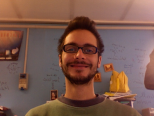Cosmology Gravitation and Multidimensions
Francesco Cianfrani
|
Francesco Cianfrani Research Statement |
The main research interest of Francesco Cianfrani was, either during his degree thesis, either in the present PhD work (he is at the beginning of the third year of his IRAP PhD), in searching for a unification picture of General Relativity and other interactions, mainly in the scheme of a geometrical interpretation of gauge symmetries, but also with respect to the quantization of the gravitational field. The point of view concerning the physics of extra-dimensions was developed with the aim to include the non-gravitational interaction into the geometry of the space-time, by representing the gauge symmetries as phenomenological issues of fundamental space-time ones. In particular, he analyzed how the unobservability of the extra-dimensional space provides tools to recast a four-dimensional phenomenology, starting from the multidimensional equations of motion. Then, he discussed the role of spinor fields in such a framework. In particular, he studied the Dirac equation on S3 by introducing an order parameter . In this regard, he demonstrated that, at the lowest order in 1/β, the solution of the Dirac equation gives a suitable dependence on extra-coordinates, such that it is possible to geometrize SU(2) gauge connections. The additional terms are highly suppressed, since 1/β gives the amount of the extra-dimensional momentum, which is expected to be negligible in a low energy approximation. In particular, a lower bound was obtain by virtue of the application to the Electro-Weak model. Moreover, Dott. Cianfrani investigated the classical analogous of spinors: rotating body. In his work, he demonstrated that the dynamics of a charge rotating object can be inferred from that of a rotating body, in a 5-dimensional Kaluza-Klein space-time. About the problem of quantizing the gravitational field, he is actually involved into a study of homogeneous quantum cosmology with the Ashtekar formulation of the Wheeler-DeWitt equation. This study aims to provide a description of a generic inhomogeneous cosmological model in terms of this first order formalism; in particular attention will be devoted to the behavior of semi-classical state approaching the initial cosmological singularity. The interest for this analysis is to be recognized in comparing the singularity properties within the Wheeler-DeWitt and Loop Quantum Gravity approaches, respectively, in the light of recent attempts to extend Loop Quantum Gravity in the inhomogeneous sector.
|
- Marco Valerio Battisti
- Riccardo Belvedere
- Riccardo Benini
- Nakia Carlevaro
- Francesco Cianfrani
- Valentino Laquaniti
- Orchidea Maria Lecian
- Simone Zonetti
